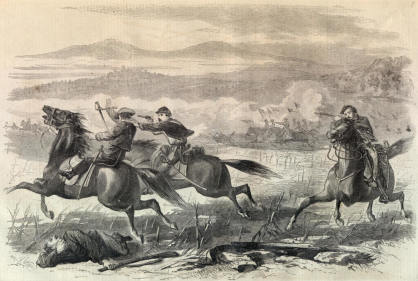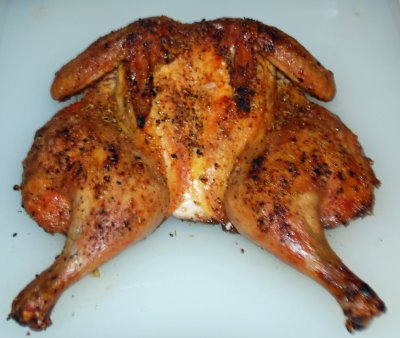Spatchcocked

I am a little late on this one- forgive me. Stuff happens. Culpeper historian Clark B. Hall nailed it on the sesquicentennial last week- the anniversary of the last raid by Union forces on our County.
Hall claims Culpeper was the “most fought over” jurisdiction in the course of the war. Some of my friends demur, saying that the residents of Spotsylvania and the Shenandoah Valley have a case, but I will stick with Culpeper pride.
We had the entire Army of Northern Virginia led by Robert E. Lee in town the winter of 1862-63, and the entire Army of the Potomac the next one, on the way to Grant’s Overland Campaign. The little knoll at Brandy Station featured dozens of engagements due to its strategic location at the fords of the Rappahannock River. But whatever.
In 1864, at the start of the Fall, Union forces made their last combat deployment to the County. After that, the fighting moved south toward Richmond and Petersburg, and all that was left for the residents here was the surrender. But the local Confederates did not go quietly, and they fought literally right on the property now occupied by the Russians and Refuge Farm.
In fact, the last general engagement of the war for this County was a resounding victory for the Rebels.
I was thinking about that when I was cutting the backbone out of a while chicken from Croftburn Farms market. I could have asked Andrew the proprietor to cut it out for me, but I suspect that he would have considered me a wimp for that.
A real chef cuts out their own backbones, you know? All it takes is a decent set of shears, or a sharp heavy knife with a wary eye to mind the fingers. A bird with its backbone removed has been “spatchcocked,” as they say Down South, and you can lay it out flat in a pan.
That is also what happened to the Union troops in the last battle in the County, but I will get to that in a minute.
You might ask me why I was removing the backbone from the chicken, and why the Heavy Hands five-pound weight was not by the back door where I pointedly ignore it and on the Corian countertop next to the heavy cast iron skillet that accompanies me everywhere. Well, every kitchen, anyway.
I am channeling Craig Clayborne, legendary food writer in the New York Times and a child of Mississippi. With the weather changing, you know that my attention has turned from outdoor cooking to savory comfort things inside. I decided to try his pressed whole chicken smothered in savory gravy, which involves a cast iron skillet (mine is an antique Erie model), butter, salt and pepper to taste, a plate, a weight, and later on, a roué of flour in the drippings to make delicious gravy and smother that chicken in.
I am thinking fresh peas from the Russian’s garden next door, some wild rice, maybe a baguette if Andrew has them in the middle of the week, and heaven out on the back deck.
From there, I could contemplate what happened in that September long ago.

(Col. Henry M. Lazelle, USA. Photo Wikipedia)
Col. Henry M. Lazelle was a Massachusetts-born West Pointer, and he brought 300 troopers of the 13th and 16th New York Cavalry to cross the Rappahannock into Culpeper with the sole objective of spreading mayhem and fear to the County.
Paralleling the Orange and Alexandria railroad tracks, the Yankees (they actually were all Yankees, led by a Yankee) rode through the eastern side of the County to cross the Rapidan at Racoon Ford, a little less than five miles from the farm.
Once across the river, they rousted some Rebel pickets and burned the rail bridge and the depot, and capturing some civilians as hostages (stop me if this sounds familiar). The Yankees then decided to commit some acts of random terror, burning several private residences, some rolling stock from the railroad, the telegraph office and a gristmill.
The raiders then wheeled north, intending to attack the Culpeper Court House on Davis Street, burning the depot at Mitchell’s Station along the way. Locals were hard pressed to respond, and the services of major combat units was required to the south on the lines protecting Petersburg and Richmond.

What did surprise Colonel Lazelle’s men was the fact that the requirement for reinforcement cause General Lee to summon a full division of troops from the Shenandoah, and they had arrayed themselves on Mount Pony, overlooking our farms and the Germantown Pike that leads east to Spotsylvania.
The Federals might have been pounding their way up the farm lane in front of our farms, and they were about to be surprised. The Rebels had artillery.
By the time Lazelle knew what he was facing, he was committed. He threw out a line of skirmishers, which drew the infantry down on his force in fury. The New Yorkers fled “in great disorder” with order transformed into a mass of “flying fugitives of both officers and men…” which must have been reminiscent of the flight of the Union Cavalry from J.E.B. Stuart the year before just north of here, near Vint Hill Farm. Stuart called that melee not a battle, but the Buckland Races.
Crossing the Germantown Pike in disarray, the flight continued north of the Rappahannock and back toward the Union main body. Lazelle lost 28 troopers, with 11 more wounded. Confederate casualties were zilch, and almost all the captured civilians managed to make their get away. The Colonel resigned his commission a month later and must have gone into politics, since he returned to military life as “Commandant of Cadets” at West Point as an appointee in 1879.
I don’t imagine he mentioned that his military legacy includes the fact that he had his butt kicked in the last battle fought in Culpeper, 150 years ago last week.
I made a note to talk to Mattski and see if we want to share the cost of a metal detector to look for things the troopers might have dropped in their haste to not have a bayonet stuck in their backsides, and turned my attention back to the chicken.
Andrew only stocks humanely-raised organic chickens, which is probably the best way to source the bird for dinner. I say that now, because there will be a better source even closer soon, when the Russians start raising their own chickens. That is going to make the minor task of removing the backbone pale in comparison with killing the bird and plucking it.
Once you get the backbone out, the bird slumps flat naturally. Take a stick of Irish unsalted butter (It is in the dairy case on the far side of the cooler) and melt it in the skillet. Season the bird to taste with salt and pepper- I normally use adobo rather than salt- but this is southern comfort food, remember.
Here is the trick- when you place the bird skin-side down in the butter at low-moderate heat, place an inverted plate atop it, and then put the weight on top to press it right down. This is the cool part. The Times says you can use a couple cans of tomatoes, if you wish, though I hardly think it matters what is in the can. The Heavy Hands five-pounder works for me.
Hell, bricks would work (though you might want to wrap them in foil.

Let it cook about 25 minutes on the one side, remove weight and plate and flip it, then replace the plate and pressure. The skin should be browned nicely on both sides, so another twenty minutes or so. Then remove the chicken and start on the gravy.
Retain a couple tablespoons of the butter and the drippings from the skin in the skillet, sprinkle the flour in to make the roué, whisking madly until it thickens, and then add chicken stock to the desired consistency. I make a lot, since there is nothing better than the gravy on the bird and worked into wild rice with a pat of butter for the string beans.
Return the chicken to the pan with the gravy and allow it to cook yet a little while longer, until tender and nearly coming off the bones. Then remove to a cutting board, hack into pieces and place on a platter. Spoon some of the gravy over the top and serve the rest on the side, with the rice and vegetables.
You could give your smothered chicken a country jolt with mushrooms and pearl onions in the gravy, as Claiborne did, or make it a Cajun fantasy with tomatoes, chopped celery, onion and green peppers added to the sauce.
Oh man. I am so happy I found a use for that damned exercise weight, you know?
Copyright 2014 Vic Socotra
www.vicsocotra.com
Twitter: @jayare303
